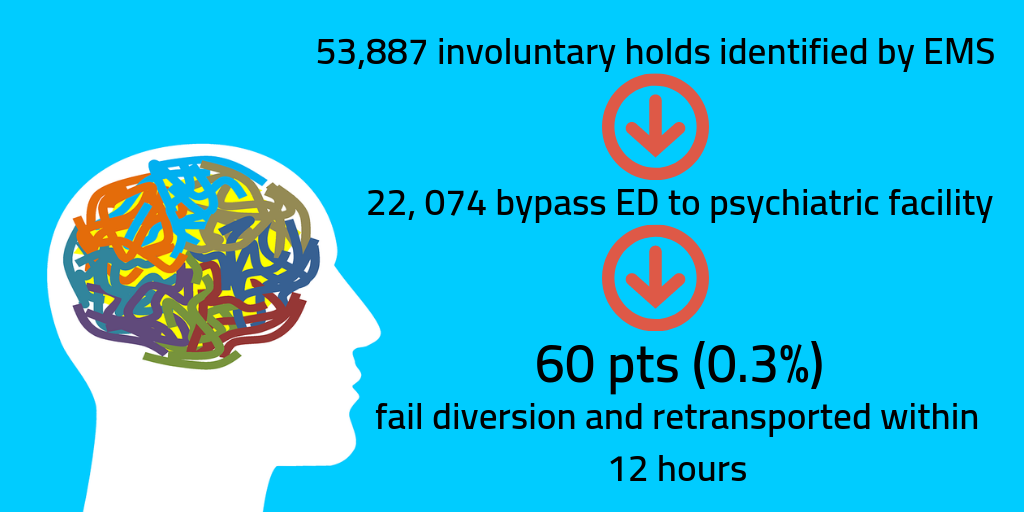Background & Objectives:
Due to a nationwide shortage of inpatient psychiatric beds, patients with psychiatric emergencies often spend long periods of time waiting in the ED for placement for psychiatric care. These long wait times are associated with more ED overcrowding, increased costs, and unfortunately sometimes inhumane conditions for patients and increased stress for staff. The vast majority of patients with involuntary psychiatric holds are brought to the ED by EMS, usually for medical clearance and evaluation for other possible non-psychiatric causes of the patient’s presentation. This study investigated the role of an EMS field protocol to allow EMS to bypass EDs and transport patients directly to a psychiatric facility.
Methods:
The investigators conducted a retrospective review of all EMS transports in Alameda County, CA between November 1, 2011 to November 1, 2016, focusing particularly on patients receiving involuntary psychiatric holds. To assess for patients who received involuntary holds, the investigators evaluated the medical priority dispatch system code, primary impression, secondary impression and medical narrative as documented by EMS providers. According to the Alameda County EMS Agency protocol (see further reading below) patients with isolated psychiatric presentations can be transported directly to a stand alone psychiatric facility provided protocol criteria is met. Two primary outcomes were examined. First, the investigators compared “involuntary hold patients” with those patients who never received an involuntary hold to identify what specific characteristics were associated with patients receiving involuntary hold status. The second outcome that was evaluated was the safety of an EMS field protocol to screen patients for direct transport to a psychiatric facility and bypass of the ED. This measure was defined by retransport of a patient to the ED within 12 hours of transport to the psychiatric facility (AKA “failed diversion”).
Key Results:
During the study period, the investigators identified 541,731 total EMS transports (257,725 unique transports). Of the total transports, 10% (n=53,887) were for involuntary holds. The key results from the study were as follows
-
41% (n=22,074) of transports for involuntary hold patients met protocol criteria for ED diversion and direct transport to stand alone psychiatric facility
-
Of patients who were transported to stand alone psychiatric facility, 0.3% (n=60) failed diversion and required retransport to ED within 12 hours
-
Involuntary hold patients were found to have significantly more total EMS use (24% of all encounters; n=128,003) compared to patients that never received hold status. They were also more likely to be younger, men, and have uninsured status
-
Of the patients requiring retransport within 12 hours, 54 of 60 of those patients developed new symptoms on arrival to the facility which did not manifest with their initial presentation to EMS. Reasons for retransport included traumatic injury (n=5), previously unrecognized or unreported symptom (n=13), seizure (n=8), excessive sedation (n=10), staff request for medical clearance of asymptomatic patient (n=7) new mental status change (n=5) or patient discharge from psychiatric service and self referral to EMS (n=5)

Takeaways:
-
Over the course of a 5 year period, an EMS field protocol to screen psychiatric involuntary hold patients for direct transport to a stand alone psychiatric facility performed safely, with only 0.3% of transported patients requiring retransport to an ED within 12 hours
-
Involuntary hold patients were usually younger and often uninsured. In addition, they had significantly higher overall EMS utilization
What this means for EMS:
This study demonstrates that implementation of an EMS field protocol can allow for safe diversion from ED directly to a psychiatric facility. The implementation of such protocol in EMS systems would likely have a significant impact on ED overcrowding and length of stay. This study highlights two important points: 1) The role of EMS with respect to hospital operations, ED operations and the health care system as a whole cannot be overstated. EMS systems nationwide may be able to build upon the lessons from Alameda County and help reduce ED overcrowding concerns as well as more rapidly direct patients to the psychiatric care they need. 2) EMS utilization by patients with psychiatric illness is significant, with roughly one-quarter of all transports in Alameda County being for “involuntary holds” during the 5 year study period. This further re-inforces the importance of both federal and local resource allocation for psychiatric illness.
Further Reading:
Alameda County EMS involuntary hold protocol:
Review and Infographic by Article Bites Editor, Al Lulla MD (@al_lulla)


